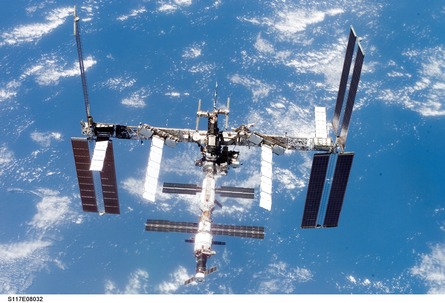NASA is discussing the commercial purchase of the European Space Agency's Automated Transfer Vehicle (ATV) to de-orbit the International Space Station (ISS) at the end of its life.
The original plan was to de-orbit the ISS into the Pacific using the Space Shuttle at the end of the station's life in 2016. But the Shuttle is to be retired in 2010 and the ATV, designed to resupply the ISS and boost its altitude, is the only vehicle known to be able to de-orbit the station.
| |
|---|
NASA is budgeting for International Space Station use until 2020 |
Development of the 20.7t (45,500lb) ATV, capable of delivering 6,000kg of useful cargo, and its Toulouse control centre and the construction of the first vehicle, Jules Verne, has cost €1.3 billion ($1.7 billion).
Its flight is scheduled for January, but ESA will know in October if its much-delayed maiden voyage is to go ahead, with four subsequent cargo delivery launches planned by 2016.
Changes in either Ariane 5 or Space Shuttle launch schedules in the last quarter could cause further delay as ISS operational rules say Shuttle, Progress, Soyuz and ATV flights cannot overlap, partly due to the availability of resources such as satellite communications and mission control support.
Jules Verne should arrive in Kourou on 29 July to start its launch campaign if its 11 July formal review approves shipping from Noordwijk.
The five ATV missions are ESA's contribution to ISS operational costs and were supposed to start at the beginning of the 21st century.
Now the two agencies have been talking about ATV use to meet NASA's cargo needs post-Shuttle retirement, but ESA says "the detailed work being done is bringing ISS back down".
Such a sixth ATV mission for ISS de-orbit would be welcomed by ESA because its original contract with European industry was for six vehicles and ESA will incur penalties if that final vehicle is cancelled.
But the ISS is now unlikely to end its operational life in 2016. Delays to completing ISS assembly and developing NASA's Orion crew transport vehicle mean the US space agency is now budgeting for station use till 2020.
However, the ATV may not be available for a 2020 de-orbit mission, even if ESA remains an ISS partner, because of costs maintaining manufacturing and operating infrastructure beyond the planned five missions.
It is not clear if NASA's Orion, to be operational from 2015, will have the propulsive power to de-orbit the ISS.
Related stories
- ESA Automated Transfer Vehicle begins qualification test
- NASA begins budgeting to extend ISS life to 2020
- NASA assesses ISS supply options after Shuttle retires
Source: Flight International




















